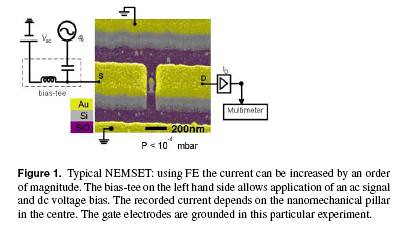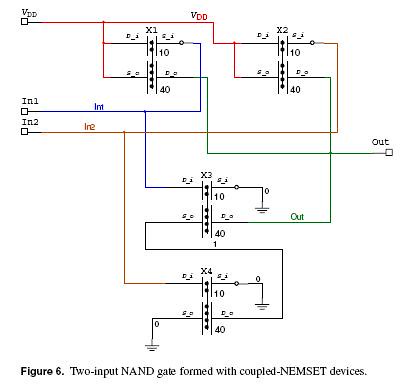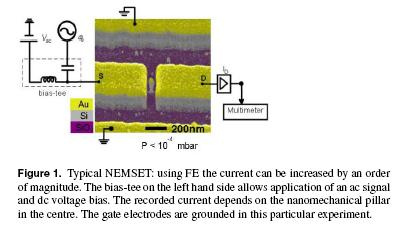Nanowerk reports on researchers who are working to build nanomechanical computers
It has to be clearly stated that current operating speeds of nano-electromechanical single electron transistors (NEMSETs) are of the order of 1 GHz, which is not competitive with standard complimentary metal oxide semiconductors (CMOS_
As we have found in recent measurements self-excitation can be exploited to generate mechanical oscillations without any ac excitation. Hence, dc voltages are sufficient to operate the NMC. Basically, a dc voltage creates an electric field to support mechanical oscillations of the nanopillars. A classical example is straightforward to construct. It has to be noted that onset of the mechanical oscillations is induced by a thermal fluctuation, which is found to be enhanced, if the electrical field is inhomogeneous.

The current work that is described as nanomechanical, will still be using DC current. However, a mechanical piece the pillar controls the flow of current.
We propose a fully mechanical computer based on nanoelectromechanical
elements. Our aim is to combine this classical approach with modern nanotechnology to build a nanomechanical computer (NMC) based on nanomechanical transistors. The main motivation behind constructing such a computer is threefold:
(i) mechanical elements are more robust to electromagnetic
shocks than current dynamic random access memory (DRAM) based purely on
complimentary metal oxide semiconductor (CMOS) technology,
(ii) the power dissipated can be orders of magnitude below CMOS and
(iii) the operating temperature of such an NMC can be an order of magnitude above that of conventional CMOS.

They have designed all of the different types of circuits that are needed. Logic elements and memory
Eric Drexler’s nanorod logic computer concepts:
Drexler’s work on nanomechanical computer concepts is not mentioned. Chapter 12 of Nanosystems. They do discuss the potential for reversible computing implementation. A summary of Nanosystems is here
There was an analysis and simulation of the Drexler Nanocomputer architecture by Bryan Wagner
The Drexler idea was based on nanoscale rod logic

Mechanism for two nanocomputer gates, initial position. One control rod with two gate knobs is seen laterally; two more rods with knobs are seen end on. Each rod with associated knobs is a single molecule

Here is an array of rod logic
NOTE: Drexler chose to model this cruder system to show that even simple and easy to define mechanical processes could have interesting performance at the nanoscale
Chapter 10 of Robert Freitas’s Nanomedicine book describes nanomechanical (Section 10.2.1) and nanoelectronic (Section 10.2.2) computers, biocomputers (Section 10.2.3), and briefly examines the ultimate limits to computation including reversible and quantum computing (Section 10.2.4).


Brian Wang is a Futurist Thought Leader and a popular Science blogger with 1 million readers per month. His blog Nextbigfuture.com is ranked #1 Science News Blog. It covers many disruptive technology and trends including Space, Robotics, Artificial Intelligence, Medicine, Anti-aging Biotechnology, and Nanotechnology.
Known for identifying cutting edge technologies, he is currently a Co-Founder of a startup and fundraiser for high potential early-stage companies. He is the Head of Research for Allocations for deep technology investments and an Angel Investor at Space Angels.
A frequent speaker at corporations, he has been a TEDx speaker, a Singularity University speaker and guest at numerous interviews for radio and podcasts. He is open to public speaking and advising engagements.

